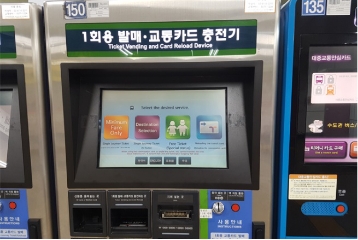- Log in
-
- Sydney Overseas Office
- London Overseas Office
- Toronto Overseas Office
- Los Angeles Overseas Office
- New York Overseas Office
- Ulaanbaatar Overseas Office
- Dubai Overseas Office
- New Delhi Overseas Office
- Manila Overseas Office
- Jakarta Overseas Office
- Hanoi Overseas Office
- Kuala Lumpur Overseas Office
- Singapore Overseas Office
- Bangkok Overseas Office
- Map
- Sydney Overseas Office
- London Overseas Office
- Toronto Overseas Office
- Los Angeles Overseas Office
- New York Overseas Office
- Ulaanbaatar Overseas Office
- Dubai Overseas Office
- New Delhi Overseas Office
- Manila Overseas Office
- Jakarta Overseas Office
- Hanoi Overseas Office
- Kuala Lumpur Overseas Office
- Singapore Overseas Office
- Bangkok Overseas Office
Contents View
-
-
-
Subway
-
03/31/2023
39.8K
-
1
2
-
-
train_station
train
travel_by_rail
subway
train_travel
-
-
-
Subway
In any city, the subway is a useful means of transportation for travelers. There is no need to experience traffic jams and the subway lines are color-coded, making it easy to navigate. In Korea today, the metropolitan area including Seoul, Gyeonggi-do, and Incheon as well as Busan, Daegu, Gwangju, and Daejeon operate subways. Seoul subway not only operates throughout the city but is also connected to other regions such as Incheon, Gyeonggi-do, Gangwon State, and Chungcheongnam-do. When using a transportation card, like the Tmoney card, you can transfer to city buses for free so it’s recommended to take advantage of it.
 【 Seoul Subway (Photo credit: Seoul Metro) 】
【 Seoul Subway (Photo credit: Seoul Metro) 】Basic instructions for using the subway
Seoul, Busan, and Daegu operate multiple lines while Daejeon and Gwangju have one line each. For the former, each line has its own unique color so you can differentiate the lines by their name and color. After you board a subway train, all transfers from one line to another are free before you walk out through a turnstile; however, an additional fee is incurred depending on the section when transferring to or from the Sinbundang Line. In all transfer stations, different lines are connected with one another through internal transfer paths. If you have a transportation card, such as a Tmoney card, you can get on a subway simply by tapping your card at a turnstile. Even if you do not own a transportation card, you can purchase a single-use boarding ticket at a ticket machine installed at every station but the fare is typically more expensive than paying with a transportation card.
Metropolitan Area Subway (Seoul Subway)- Seoul Metro website: www.seoulmetro.co.kr (Korean, English, Chinese, Japanese)
- See Seoul subway map
Make sure to check out the Seoul Metro website
The site helpfully introduces everything from themed tour attractions to detailed subway usage guides in English, Chinese, and Japanese. Also, the FAQ section is great to prepare for any unexpected emergency situations.
* In case of an emergency, contact the station authorities by using an emergency phone installed on all subway station platforms or call the Seoul Metro customer center at +82-1577-1234.Busan Subway- Busan Transportation Corporation website: www.humetro.busan.kr (Korean, English, Chinese, Japanese)
- See Busan subway map
Busan subway stations offer one- or three-day tickets that allow unlimited rides within the specified period so take advantage of it!
For more detailed information, refer to the Busan subway fare guide. (Korean, English, Japanese, Chinese)
Daegu Subway- Daegu Transportation Corporation website: www.dtro.or.kr (Korean, English, Chinese, Japanese)
- See Daegu subway map
Daejeon Subway- Daejeon Transportation Corporation website: www.djtc.kr (Korean, English, Chinese, Japanese)
- See Daejeon subway map
Gwangju Subway- Gwangju Transportation Corporation website: www.grtc.co.kr
- See Gwangju subway map
Tip 1. Purchase a single-use transportation card and receive your deposit backSingle-use subway cards can be purchased at a ticket vending machine for an additional 500 won as a deposit. Afterwards, return the card at a deposit refund machine to get the deposit back. Simply insert the card in a deposit refund machine at the destination to get the refund.
 Tip 2. How to use a locker
Tip 2. How to use a lockerLockers for storing your belongings are installed at most subway stations. Fees vary depending on the size—small, medium, and large—and the storage time may also vary according to the terms of use for each facility. You can pay with a bank card or a transportation card and certain lockers can also be paid with cash. Most lockers also offer instructions in multiple languages.
Travelers in Seoul can also benefit from the T-Luggage service available in Seoul subway stations. It offers luggage storage as well as carrier services, assisting with the movement of your belongings within the station, between stations, and even from and to Incheon International Station, all on the same day—allowing you to enjoy your time without having to carry your luggage around. T-Luggage is available in major Seoul subway stations such as Seoul Station, Hongik Univ. Station, Myeong-dong Station, and Gimpo Int’l Airport Station.
✔️ Take advantage of foreigner-exclusive transportation cards—click here for details!
* 1330 Korea Travel Hotline: +82-2-1330 (Korean, English, Japanese, Chinese, Russian, Vietnamese, Thai, Malay)
* This page was last updated on September 19, 2025, and therefore the information may differ from what is presented here.





